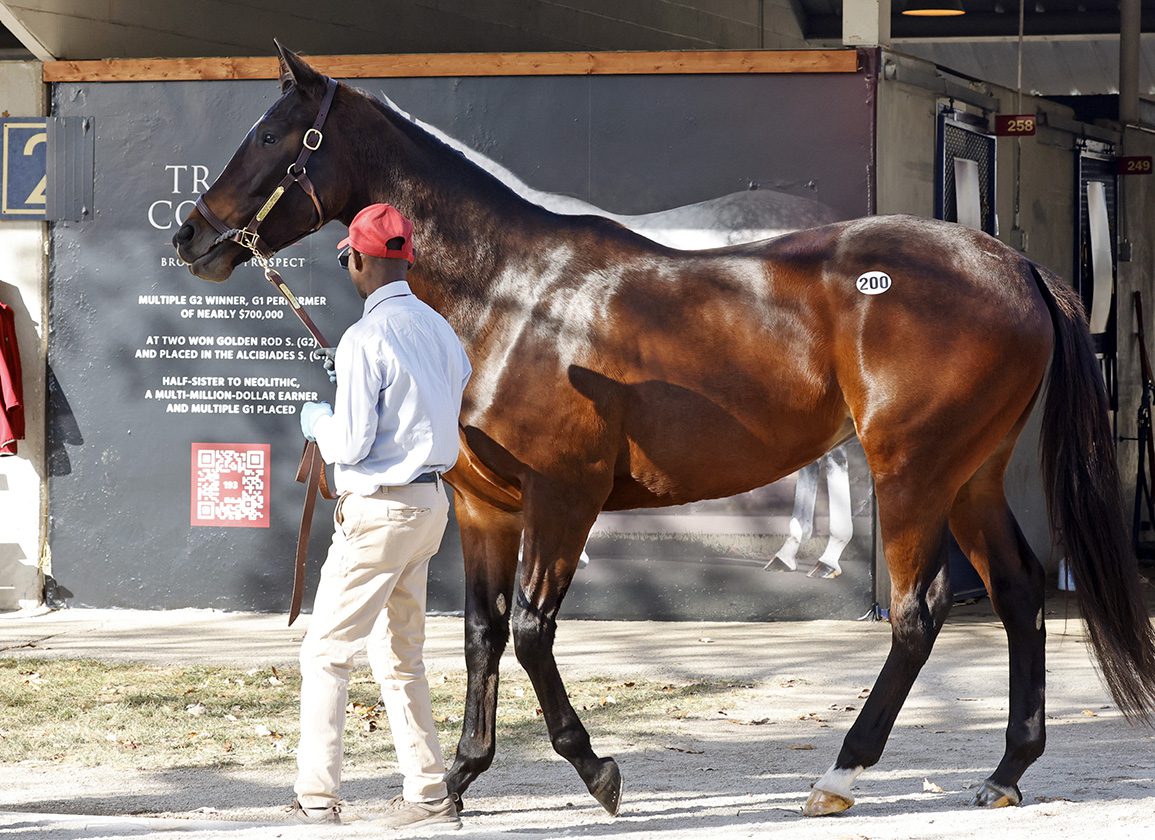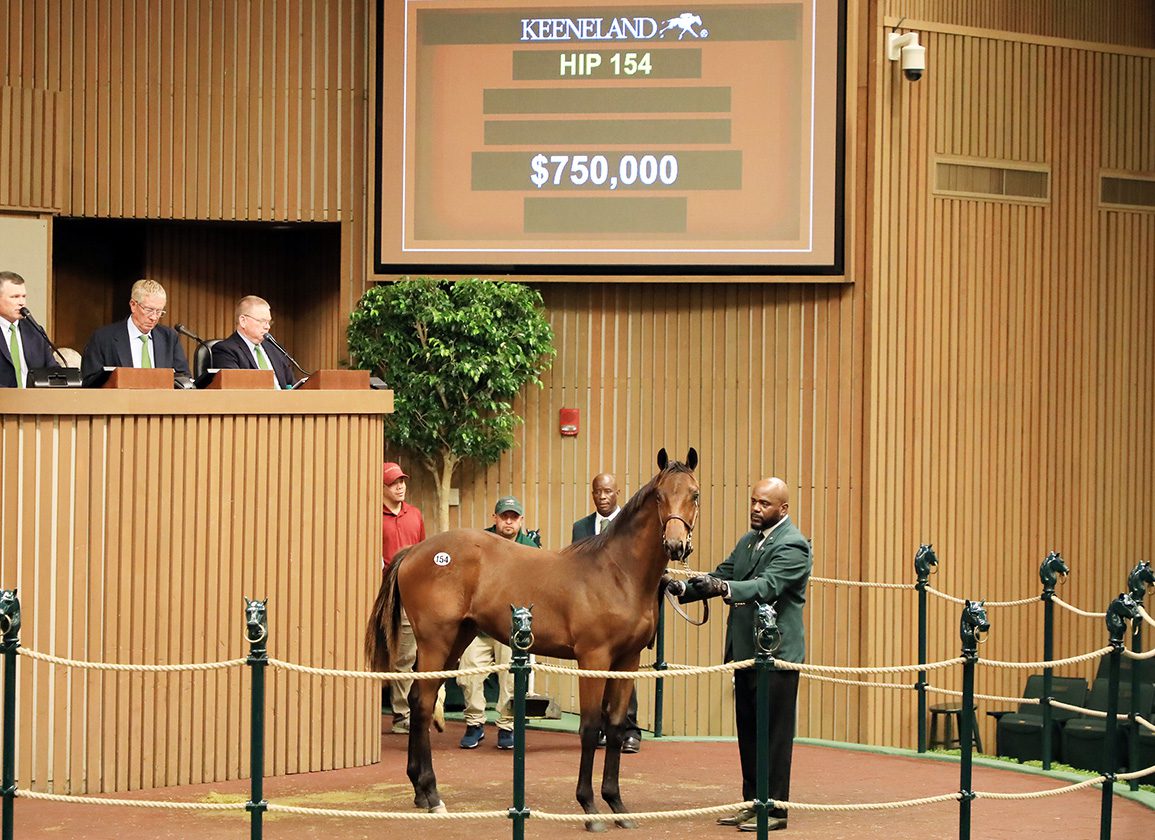By Katie Petrunyak
After wrapping up the annual whirlwind doubleheader between the Fasig-Tipton and Keeneland November breeding stock sales, Mark Taylor has a lot to be grateful for as he reflects on another successful year for the Taylor Made Sales consignment.
Taylor Made was the leading consignor at both auctions, with 35 horses sold at Fasig-Tipton for $22.965 million and 262 sold for over $22.8 million at Keeneland. While the Lane's End consignment beat Taylor Made out for the title last year at Keeneland by a little under $500,000, Taylor Made was back on top this year for the 26th time since 1987.
“Our market share at Fasig-Tipton was 22.8%, which is pretty healthy for us, and our market share at Keeneland was 12.5%,” said Taylor, the President and CEO of the eminent leading sales consignment. “It's really a testament to our great team. I think the Taylors have surrounded themselves with really talented people, many of whom could have their own consignments if they wanted to but they prefer to stay on our team under our umbrella. Then we have awesome customers who have been with us in many cases for decades. It's not about Taylor Made or our horses or anything like that, it's about the customers and you've got to help them find success to continue to receive their support.”
At Fasig-Tipton, Taylor Made's highlights included the $3.2 million sale of champion Wonder Wheel (Into Mischief), selling three Grade I producers for seven figures, and offering two of the top three highest-selling weanlings. At Keeneland, the consignment sold the top-selling foal, a $750,000 Gun Runner colt that went to Shadwell Racing.
Of course, not everything was rosy as numbers were markedly down in many segments of the market. The polarization that has been a common narrative in recent years was once again a salient theme as the last major sales of 2023 came to a close.
“It's been going on for a long time, but I do think that it was more evident and that there was some correction this year as we got into the breeding stock sales,” said Taylor. “There were definitely a lot more mares going through pregnant to popular first-year or second-year stallions or popular proven stallions that you could buy for the stud fee. I was shocked. One of our customers reacted quickly and went in there and bought six mares all in foal to nice horses roughly for their stud fees. If they're good-looking foals, these foals could be bring $150,000 a piece and they were buying the mares for $30,000 or $40,000.”
In a buyer's market, any extra help that a consignor could provide for their clients might go a long way. Taylor said he was proud of how his team responded to the added challenge.
“We've got all the Taylor brothers, plus we've got eight Thoroughbred advisors that are all working synergistically to help each other get our horses sold,” he explained. “We were actually up 23.3% versus last year at Keeneland and 5% at Fasig. I think that in a little bit of a tricky market, that's where we really shine because we have a lot of people to hustle horses. The market is adjusting and we can help adjust reserves too. I think that's where our size can be a real asset in a lot of situations.”
With a buy-back rate of 24.9% at Fasig-Tipton and 21.99% at Keeneland, sellers were judicious as they set reserves, but there was still plenty of demand as the RNAs-to-sales activity doubled at Keeneland compared to last year.
Taylor said that their team has been busy selling horses long after the last offering went through the ring.
“There was a mare from Fasig-Tipton that we sold just this week for $275,000,” he reported. “Sometimes the word RNA is like a dirty word. Nobody wants to talk about it. But within Taylor Made, we're okay with it. Sometimes the horse was just in the wrong part of the sale and it got overlooked and then two days later, it looks like a star.”
Like several consignors have noted, Taylor said that many of their clients that normally sell their foals as weanlings held onto their higher-end offerings to sell next year.
“There's one of our big customers, and they're some of the best breeders in America. For decades, a staple of their program was selling a large percentage of their best offspring as weanlings. They still sold some very good ones this year–they had one sell for $750,000 at Keeneland–but in general, those ones that maybe were going to go for $150,000 or $250,000 as weanlings, they said, 'With the way the market is going, the best way for us to maximize our sales crop is to hold onto those.'”
“Let's say you're a relatively small breeder,” he continued. “You breed six to eight foals a year and you've got one that is the star of the show. That's your home run potential that could pay for all the others. The other ones are going to pay the bills, but your profit is going to be what that one horse brings. Even if you have a great sale for a weanling and it brings $300,000, if somebody turns around and gets $750,000 for it the next year, for some of these breeders that's just money they can't afford to loose.”
Taylor predicted that the pinhookers who jumped at opportunities at Fasig-Tipton or early on at Keeneland will be rewarded.
“I don't think that the pinhookers really understood that they were going to run out of quality sooner than they typically do,” he said. “I thought that there were some horses in Book 1 that people made good buys on. They seemed like they paid a lot at the time, but if that same horse would have been in Book 3, it probably would have brought more because there just weren't that many weanlings with pedigrees left. It was an interesting dynamic. I think that the pinhookers will adjust next year and maybe be a little bit more aggressive at Fasig. There were probably some pretty decent buys in there in hindsight.”
Taylor pointed out two evolving trends that he believes will impact any market correction and might diminish breeders' profitability going forward.
He started with the increase in stallions' book sizes. Taylor is quick to note that Taylor Made's own Not This Time bred 200 mares this year and said he does not disparage the stallion farms, but rather considered the significance of the market's reaction to an uptick in the number of horses sired by the same stallion presented at the sales.
“In my dad's era, it used to be 40 mares,” he said. “Then it crept up and I remember when 100 or 150 was a lot. Now it's like we're bumping up against 300. What this does for a lot of smaller breeders is they feel like they've got the golden ticket because they're getting into this horse that they really like. They used to not be able to get into this horse when he could only breed 120 because none of their mares were good enough. Now that they can get in, it's actually backfiring.”
Heightened scrutinization from buyers when it comes to X-rays, he continued, is another factor that has increased costs for breeders.
“Thirty years ago, nobody did spring X-rays,” he explained. “Now you do spring x-rays, which are $600 a pop. Then a ton of these horses have little P1 chips. In my opinion it would be great for the breed if everybody would sign a document and say, 'I'm not going to discount a yearling at the sales because of P1 chips that are not clinical.' Now not only do you take the two sets of X-rays and multiple scopes, but you add in the surgery costs. You're taking an equine athlete during the prime time their skeletons are supposed to be developing and putting them in a stall for 45 or 60 days. If you told me that all you want to do is race, I would much rather buy a horse with a little P1 chip that had never been put up in a stall.”
“These breeders are facing rising costs and unless you have a mare that can produce a six-figure foal consistently, it's hard to make money,” he admitted.
And so, Taylor said, he is proud that their sales team was just as active recruiting buyers during the ninth and final day of Keeneland as they were during the opening session.
“We realize that for the people selling the $40,000 foal, in some case that money means more to them that any of these horses we sold in Book 1 at Keeneland or at Fasig-Tipton. That foal bringing $50,000 instead of $30,000 can really help someone's cashflow, so even though that's not the part of the market that we're focusing on and that we're actively recruiting in, if somebody gives us their horse to sell, they're going to get our best effort all the way through the end.”
Not a subscriber? Click here to sign up for the daily PDF or alerts.








